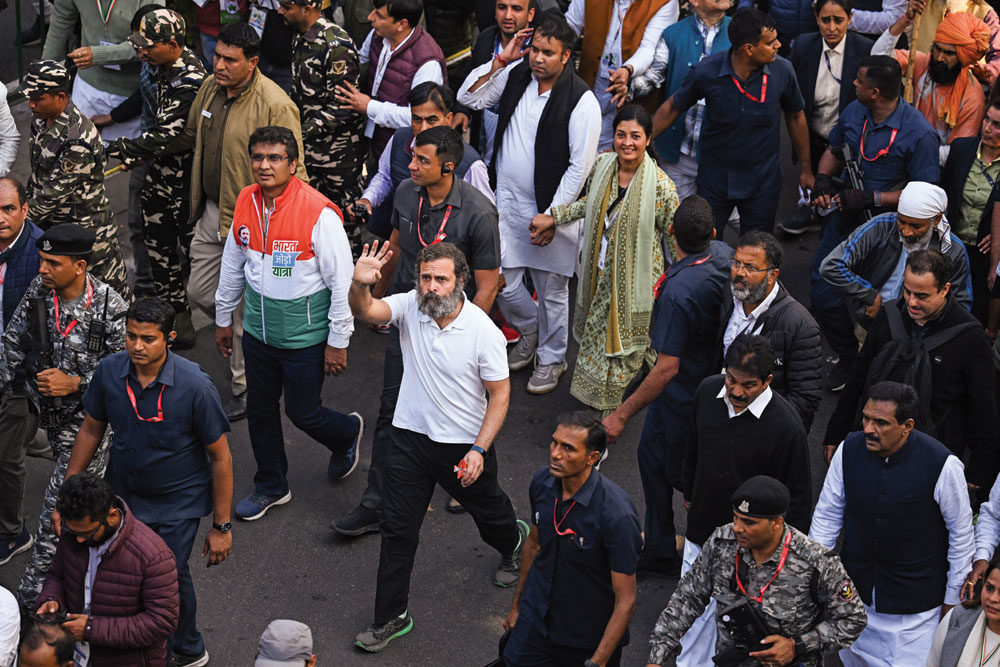A Home Run for 2024
Modi’s attack on freebies and his emphasis on development-cum-welfare will define the BJP campaigns for the upcoming Assembly elections
 Rajeev Deshpande
Rajeev Deshpande
 Rajeev Deshpande
Rajeev Deshpande
 |
06 Jan, 2023
|
06 Jan, 2023
/wp-content/uploads/2023/01/Homerun1.jpg)
(Illustration: Saurabh Singh)
AHEAD OF THE 2019 Lok Sabha polls, there was considerable unease in the Bharatiya Janata Party (BJP) ranks. Opposition Congress’ poll promise to transfer ₹72,000 a year to India’s poorest families had rung alarm bells. The amount pledged was much more than any scheme offered by the government, such as the PM Kisan Samman Nidhi (₹6,000 a year for small farmers) or benefits under Ujjwala or Saubhagya (subsidised LPG gas and electrification of all households). Some commentators and think-tanks saw the NYAY (minimum income scheme) as a gamechanger. Many in BJP feared this could be the case and called for counter-measures. Announce an “urban MGNREGA” said some. Others felt farmer income support should be upped. Prime Minister Narendra Modi disagreed with the suggestions. “If we are to do the same, what are we here for? We might as well go home,” he told aides and party functionaries.
This was not the first time that Modi had dug in his heels. As chief minister of Gujarat he had resisted election-time pressures to announce free electricity. But this was the General Election and the stakes incalculably higher. Modi firmly believed that a series of welfare measures rolled out by the Centre, which included improved versions of MGNREGA (rural employment guarantee) and the National Food Security Act (NFSA), would convince voters about BJP’s commitment to the poor. The results bore him out: Congress barely improved its tally from 44 in 2014 to 52 in 2019. More recently, in the midst of the campaign for the Gujarat and Himachal Pradesh Assemblies, Congress’ advocacy of the Old Pension Scheme (OPS) was seen to be hurting BJP, particularly in the hill state. Suggestions to fashion a promise that would enhance pensions, even if not revert to OPS, were firmly turned down. BJP lost the Himachal election narrowly, but it remains unclear how much the OPS issue had to do with it. In any case, Modi was clearly against undercutting the pension policy of the Centre and opening the door to more concessions that he felt would be fiscally irresponsible.
Official sources point to the decision to discontinue the Covid-time free ration scheme for the poor, despite 2023 being studded with nine state elections leading to the 2024 General Election, as another instance when Modi bit the bullet. Though the Centre softened the blow by announcing that it will distribute foodgrain under the public distribution system (PDS) free of cost, ending the free rations scheme defied conventional thinking that benefits once offered are hard to withdraw. It was an act of political courage to end a scheme that had outlived its utility and in some instances led to families receiving 50kg of foodgrain a month. Inevitably, the excess cheap foodgrain was finding its way to the market for profit. Despite taking over the PDS subsidy, the decision will save the Centre ₹1.5 lakh crore a year, an amount that can be more fruitfully employed. The prime minister’s point is simple enough say officials who have worked with him. Assistance must be offered to those who need it and welfare measures must not move too far from the principles of economic viability. This conviction led Modi to announce an audacious war on “revdi culture (freebies)” in the midst of the just-concluded state elections when the Aam Aadmi Party (AAP) was seeking to woo Gujarat voters with its ‘Delhi model’ of free electricity and water and ` 1,000 a month to all women above 18. Congress promised 300 units of free power and, as it did in Himachal, a return to OPS.
The Prime Minister’s point is simple enough say officials who have worked with him. Assistance must be offered to those who need it and welfare measures must not move too far from the principles of economic viability. This conviction led Modi to announce an audacious war on ‘revdi culture’
In the year ahead, with its relentless procession of state polls beginning in February, when three Northeast states are due to elect governments, to the year-end when Madhya Pradesh, Rajasthan, Chhattisgarh and Telangana will vote, parties will definitely take recourse to dollops of populism. BJP, too, will do its share of electoral management through manifesto promises. But the party’s compass will be set by the prime minister who is expected to stick to the principles he has outlined in his attacks on freebies. The electoral trend he will seek to set will retain its focus on a massive development push through building infrastructure, complemented by saturation coverage of welfare schemes so that most beneficiaries are reached. These are the building blocks for the campaigns ahead, apart from the poll-time rhetoric and emotive-cultural issues that seek to mobilise voters and state-specific variations. During a particularly challenging state election in Gujarat, Modi had remarked to his aides that the government had done nothing to cause voters to show it the door. In succeeding elections, he has ensured BJP displayed a positive ‘pull factor’ rather than a dependence on the more passive TINA (there is no alternative) formulation.
It is an oft-repeated truism that state elections are largely about local and regional issues. The results of various Assembly elections appear to bear this out as voters distinguish between choosing a national government and one in the state capital. Yet, the state elections due in 2023 will, despite their regional character, be scene-setters for 2024. If the likely election in Jammu and Kashmir post-abrogation of Article 370 and post-delimitation is also added to the tally, 2023 is brimming with political blockbusters. And as has been the case since 2014, Modi will be a factor in each of them. With BJP in office directly or as a partner in five states going to polls, the onus will be on the party to retain its geographical imprint and expand it in order to consolidate its pole position for the 2024 Lok Sabha polls. It has, despite a narrow loss in Himachal, ended 2022 on a high by winning a massive, cross-sectional mandate in Gujarat and decisively defeating caste-based parties in Uttar Pradesh (UP) earlier in the year. Beating the revolving door in Uttarakhand and ending a tradition of fractured mandates in Manipur and Goa were a welcome bonus. AAP’s emergence in Punjab—where BJP was previously a junior partner to the Akalis—was a setback but the new government soon courted controversy, losing some of its sheen. The year ahead presents a different set of challenges for the opposition, mainly Congress. If Rahul Gandhi’s ‘Bharat Jodo Yatra’ is to show results, Congress must acquit itself honourably in states like those in the Northeast where it once held sway, defend Chhattisgarh and Rajasthan, and take on BJP in Karnataka. Winning every battle is obviously a tall order but if Congress does not do well, other opposition parties will not take it seriously, let alone consider Rahul Gandhi’s plea for coordination and a vision to oppose BJP.
IN 2018, BJP won a major ideological battle, toppling the long-running Marxist government headed by its veteran Chief Minister Manik Sarkar in Tripura. BJP and its partner, the Indigenous People’s Front of Tripura, won a decisive victory with more than 50 per cent of the vote. Along with Meghalaya and Nagaland (where BJP is part of the ruling coalition), Tripura will go to polls in early 2023. It will be a test for BJP’s Northeast mastermind, Assam Chief Minister Himanta Biswa Sarma, who has fashioned a successful strategy for the region. Backed by Union Home Minister Amit Shah, Sarma has shrewdly forged issues of illegal immigration and identity to overcome the Northeast’s traditional faultlines of ethnicity and language and kept rivals like the Left and Trinamool Congress at bay. BJP’s strategies involve fording divides like the resentment against Bengali speakers by working on a larger narrative against illegal immigration from Bangladesh and the Rohingya influx. So far, trip wires like the Citizenship Amendment Act (CAA) and the Assam Accord have been negotiated, with the Centre submitting to the Supreme Court that CAA will not impact the language and culture of Assam and does not encourage future migrant inflows. As CAA rules are yet to be framed, BJP will like to keep the sensitive matter dormant ahead of the state polls.
Apart from anticipated local considerations, the prime minister is expected to press his integration theme in the Northeast, arguing that BJP has sought to present an efficient and transparent alternative to the cash-and-carry politics that has been the bane of the region. The concerted effort to expand road, rail and air links is an important part of BJP’s bid to retain its perch. Added up, the Northeast accounts for a useful chunk of 23 Lok Sabha seats that can be very handy in forming a government at the Centre. BJP’s political project envisages recognition of the distinctive traditions of tribal heroes and culture while situating them within a nationalist narrative. This is diametrically opposite to the view that sees these communities as disparate ‘nations’, a trend that has encouraged insurgencies. BJP hopes a development footprint and incorporation of local identities and aspirations will overcome religious appeals (the Northeast has long been a battleground between the Sangh and Christian evangelists) that vehemently oppose Hindutva.

The Karnataka elections due in May possibly pose the sternest test for BJP. There are many factors at play in the state where BJP effected a transition, installing Basavaraj Bommai as chief minister and bringing the curtain down on veteran BS Yediyurappa’s (BSY) career in office. The difficult shift is still a work in progress. Necessitated by BSY’s age and partly due to troubling talk of filial loyalties, the change is a bold gamble. In the last Assembly election, BJP’s 104 seats were a tantalising nine short of majority and the party had to watch as Congress—whose tally dipped by 44 seats to 78—supported Janata Dal (Secular), or JD(S), leader HD Kumaraswamy to form a government. BJP turned the tables on the coalition through defections of Congress MLAs, but a significant number of defectors had to be made ministers, skewing the regional balance. The ‘compromise’ meant carrying a baggage and limiting the party’s own agenda. But the situation on the ground, say political sources, is not as dire as some analysts make it out to be. The decision to hike Scheduled Caste and Scheduled Tribe quotas is seen to be significant. A series of communally tinged crimes in coastal Karnataka has raised the temperature, posing a law and order problem, but also resulting in polarisation that BJP looks to harness while JD(S) and Congress compete for minority votes.
Working to BJP’s advantage is the sharp rivalry between Congress stalwarts like former Chief Minister Siddaramaiah and DK Shivakumar, who remain unreconciled over their rival claims to leadership. The elevation of former minister and senior leader Mallikarjun Kharge as Congress president is not likely to make a significant difference to this situation. JD(S) and Congress have so far shown no inclination to contest the election together, even as Modi makes it a point to show due deference to HD Deve Gowda. As the war of words over Shah’s recent comments on cooperation between Gujarat’s dairy giant Amul and Nandini, which Congress and JD(S) claimed was an attempt to “take over” the Karnataka outfit, shows, it will be a fierce fight. The BJP leadership hopes to win the state and then take the next step to form a government and set an agenda that is less affected by coalition compulsions. Retaining Karnataka is an important part of BJP’s bid to mark a presence in other southern states like Telangana, which is also headed for polls later in the year.
In Chief Minister Shivraj Singh Chouhan in Madhya Pradesh, BJP has one of its most successful leaders. He established that BJP is not a party that won in reaction to Congress’ failures alone and that it could repeat its success. He made his way back after Congress failed to accommodate the claims of Jyotiraditya Scindia, leading to his embrace of BJP. Despite some uncharacteristic actions, such as harsh on-the-spot punishment for erring officials and use of the demonstrative bulldozer against residences of rioters, Chouhan is an experienced administrator and BJP’s best bet. A state with a large tribal population, Modi’s pitch for “saturation” coverage of welfare schemes is an important electoral issue. Though it presents its set of challenges, Madhya Pradesh is familiar territory for BJP which has an impressive machinery. Neighbouring Chhattisgarh is likely to be Congress’ best prospect with Chief Minister Bhupesh Baghel getting the better of in-house rivals and BJP, the latter still trying to move beyond the Raman Singh era. A more effective BJP would have been able to use repeated violence over conversions to its advantage. While Baghel retains his primacy, Rajasthan Chief Minister Ashok Gehlot has fended off Deputy Chief Minister Sachin Pilot’s claims to leadership. He drew a thick red line recently when he said the credentials of a “traitor” would not be accepted by party legislators. BJP, too, has a leadership issue to settle between former Chief Minister Vasundhara Raje—by far the party’s most popular leader—and her lesser rivals, but its problem is not as severe as that of Congress.

/wp-content/uploads/2025/07/Cover-Shubman-Gill-1.jpg)












More Columns
Shubhanshu Shukla Return Date Set For July 14 Open
Rhythm Streets Aditya Mani Jha
Mumbai’s Glazed Memories Shaikh Ayaz